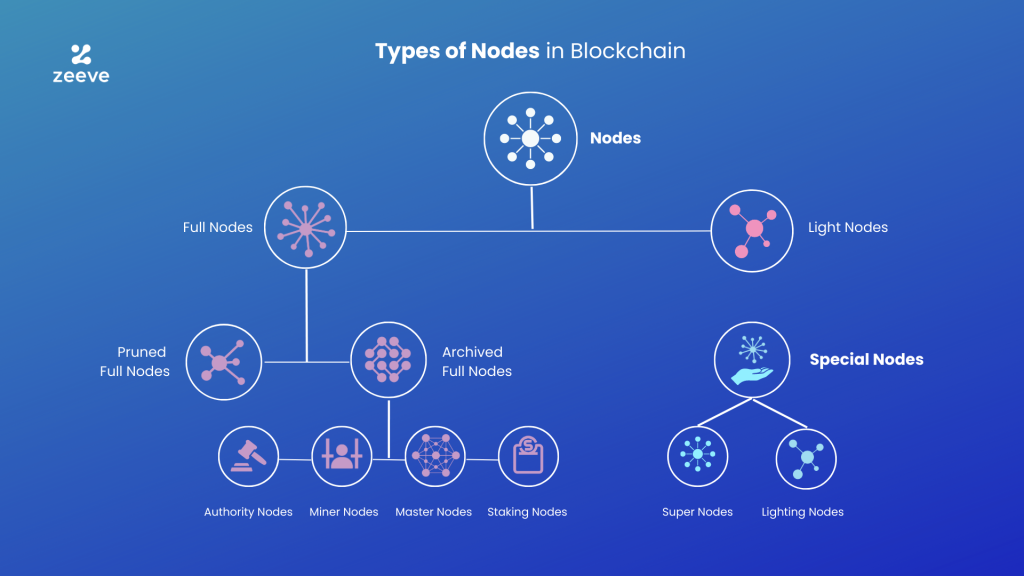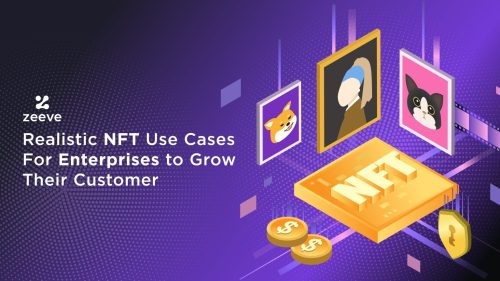
Beyond the Blocks: Different Types of Nodes in Blockchain Networks
Blockchain technology has transformed the way we usually work around data storage and security. With its ability to decentralize data, blockchain is transforming the way we view and interact with technology on a global scale. The technology offers a secure and decentralized way to store and manage data, which has enabled the development of a wide range of applications across various industries, including finance, IT, data management, real estate, healthcare, entertainment, telecom, security and insurance, and many more. In understanding and applying the technology, it is also essential to understand the integral components of it and the most important one is blockchain nodes.
In general terms, Nodes blockchain are computers connected to the blockchain network which take on the task of verifying and relaying transactions across the network. These computers are essential for the network to function properly and for transactions to be securely recorded.
They are the backbone of the distributed ledger system, forming the backbone of the blockchain network. In essence, blockchain nodes are the gatekeepers of the blockchain, ensuring that all transactions and blocks are legitimate and valid. In this blog, we would delve deeper into the basics of blockchain nodes, how important they are for blockchain to function, how blockchain nodes work and the types of blockchain nodes. So let’s get started.
Overview of Blockchain Nodes- what are they?
You have heard of blockchain but wondering about what is a node in a blockchain, then read on more to know in depth the node in blockchain and what are the three different types of nodes in blockchain. A blockchain node is an electronic device that stores and maintains a copy of a blockchain ledger, and it is connected to the blockchain network and has a unique IP address. It is an essential part of the blockchain network and its exact role varies depending on the uses cases and type of the blockchain.
This ledger is a distributed public database of digital data that is shared among a global network of connected computers and is largely responsible for relaying and verifying transactions. Each blockchain node stores a complete copy of the entire blockchain ledger, which is updated and maintained through the consensus of participants in the network. The nodes validate and propagate new blocks of data across the network, and if you are wondering how blockchain nodes communicate with each other, then be aware that they function as communication terminals, allowing users to interact with and through the system.
The nodes store the blockchain ledger, verify transactions, and then broadcast them over the network. However, not all nodes perform the same function; some store transaction records while others may not store any. In a blockchain network, there are potentially multiple types of nodes. For example, the Corda platform has two distinct types of nodes: those responsible for validating transactions and those for clients. Each of these nodes provides a unique set of services that are necessary for the network to function.
The validator nodes are responsible for ensuring the accuracy of transactions, while the client nodes provide the interface for users to interact with the blockchain. By combining these two types of nodes, Corda is able to ensure that the blockchain is secure and reliable, while also enabling users to access the network.
These nodes are essential to the functioning of a blockchain network as they validate, store and synchronize transactions across the network. Further, improve the security of the network. Let’s understand how blockchain nodes operate in order to use this technology effectively.
Working of blockchain nodes: how do they operate
Blockchains are decentralized networks, meaning that they require a mechanism to process transactions and make decisions about the network. The consensus rules are unique for each blockchain, which determine the number of nodes required to approve a transaction. While some blockchains require just one validator node to approve a transaction, others require the approval of a committee of nodes.
It is through voting that changes or upgrades are made to the network. This is determined by all the nodes linked to the blockchain. A majority of the nodes must approve of the change in order for it to go through. For instance, the latest Ethereum London Hard Fork upgrade was approved after it received 85% of the votes cast by the nodes. By understanding the purpose and function of blockchain nodes, users can ensure that the data stored on the blockchain is accurate and secure, as well as gain a better understanding of how the technology works.
Purpose of Blockchain Nodes
Blockchain nodes are a fundamental part of the technology that enables them to function. Nodes are essential for the blockchain to operate as they verify transactions and participate in consensus protocols. Furthermore, they are key in achieving decentralization as they provide the computing power needed to keep the blockchain secure and decentralized. In addition, they help to ensure the security of the blockchain network by verifying transactions, providing a level of trust, and preventing double-spending. Blockchain nodes are a critical part of the blockchain infrastructure, and are necessary for the blockchain to function properly and securely.
It has been previously noted that various nodes in a blockchain are allocated different roles. Generally speaking, these nodes serve three main purposes.
Maintaining the blockchain networks: The blockchain is a decentralized ledger, meaning that there is no centralized server storing its database. In order to ensure scalability, blockchain networks like Ethereum and Bitcoin rely on thousands of nodes across the world to store their blockchain data. Every single node holds its own version of the blockchain, consistently syncing as new blocks are generated. Maintaining this blockchain requires careful upkeep of the nodes, ensuring that they are up-to-date with the latest version of the blockchain.
Verifying a transaction on the blockchain happens in several steps. First, nodes on the network receive the transaction order. Then, they check the authenticity of the transaction by verifying the sender’s address and the amount of funds being sent. Next, they approve or reject the transaction. Finally, if the transaction is accepted, it is recorded on the ledger. Validator nodes may also broadcast the suggested decision to other nodes in order to maintain consensus.
Accessing information: Blockchain nodes access information by downloading the entire blockchain and verifying the blocks of data stored within it. Nodes can then convey information with each other to verify and validate the data stored within the blockchain, ensuring its accuracy and security. This process is key to the success of the blockchain network, as it allows information to be securely stored and transferred without a central authority.
Types of Blockchain Nodes
Blockchain nodes are categorized according to the tasks they are meant to execute.
Full nodes:
Most of the times when someone mentions a “blockchain node” they usually refer to a full node. It is responsible for saving the blockchain’s transaction history. This makes it the server of the blockchain. Additionally, full nodes play a part in consensus models such as Proof of Work (PoW) and Proof of Stake (PoS). Prior to any changes or additions being implemented, the network verifies that all the full nodes are ready for the update. This also puts them in charge of the governance of the blockchain. This type of node is further divided into two subcategories as is discussed in the following section.
Pruned Full Nodes
These nodes save blocks on a hard disk by discarding the oldest blocks first. These nodes must initially download the blockchain onto their hard disks and then gradually delete the oldest blocks until the storage limit is reached. If a pruned full node has a storage limit of 500MB, it will store only the records of the most recent transactions, up to the limit. This node will stay synced with the network, adding the latest records while deleting the oldest, to remain within the storage limit.
Archival Full Node
Archive nodes in blockchain are nodes that store the complete blockchain data. They keep a complete record of the entire blockchain history, including all transactions, blocks and related data. Archive nodes are usually used by miners and developers to keep an up-to-date record of the blockchain. Besides verifying transactions, they also ensure blockchain security. They are a key part of the blockchain infrastructure and help to ensure that the blockchain remains secure and reliable.These are nodes with no fixed storage restriction and are the most prevalent type of blockchain nodes. This type of node is further classified into authority nodes, miner nodes, staking nodes, and masternodes.
Authority Nodes
In a public blockchain, someone becomes a node by downloading and synchronizing the data on the blockchain network. This access is open to all participants, enabling anyone to join and be a part of the network. By contrast, access to private and some partially-centralized blockchains is limited to certain authority nodes, which can control and restrict the access of the other nodes.
Miner Nodes
Blockchains that are based on the Proof of Work consensus model, such as Bitcoin are required to have miner nodes. To approve transactions, they must solve difficult mathematical problems, which require powerful computing devices and large amounts of electricity. After the successful addition of blocks, the miner node receives the incentive, which is newly-minted tokens.
Staking Nodes
Nodes that verify the legitimacy of transactions in a blockchain using the Proof of Stake model are known as staking nodes. To establish a staking node, users must lock a specific amount of the underlying tokens of that blockchain ecosystem. The system then randomly selects one of the staking nodes to process and register deals on the ledger following some pre-defined criteria. For instance, some blockchains take into account the amount of funds locked, while some consider the amount of time spent on the blockchain. Compared to miner nodes, staking nodes require significantly less energy to validate transactions.
Masternodes
Masternodes are full nodes or more simply can be said as a special type of node that is used in certain blockchain networks but they do not have the ability to add new blocks. They are responsible for providing additional functions in the network, such as processing transactions, verifying network integrity, and enabling instant transactions. In 2014, Dash was the first blockchain to incorporate masternodes into its network architecture. Masternodes are also responsible for generating new coins, which is why they are often referred to as miners. Masternodes also provide a unique way to earn rewards and are a great way to invest in cryptocurrency. They require a large amount of collateral in the form of coins, and they also require a certain amount of technical expertise to manage.
Light Node
A light node is a computer that is connected to a blockchain network and stores a copy of the entire blockchain, but does not process or validate transactions. It is also called Simplified Payment Verification (SPV) nodes and is the second most common type of blockchain node. The Light nodes are typically used by end-users who are interested in using a blockchain platform, but do not need to process or validate transactions. They are lightweight and easy to set up, making them suitable for individuals who do not have the technical know-how or resources to run a full node. These nodes are designed to enable faster transactions and daily activities, and are thus equipped with the ability to store only the essential information from the blockchain, such as blockheaders, thereby saving users time and storage. Light nodes are also useful for applications which require quick access to a blockchain, such as decentralized applications (dApps).
Lightning Nodes
The Lightning Network is a payment system that uses off-chain transactions to facilitate faster and cheaper payments than traditional on-chain transactions. When a blockchain network is congested, users can encounter long wait times for their transactions to be processed. Lightning nodes create a connection between the blockchain network and external users and are utilized to minimize latency and expedite the completion of transactions with minimal fees. Lightning Nodes are responsible for providing the infrastructure for the Lightning Network and allowing users to send and receive payments. They provide liquidity to the network by maintaining channels and allowing users to open new channels with other Lightning Nodes. Lightning Nodes are incentivized to keep the network running and are rewarded for their efforts with fees from transactions.
Super Nodes
Super Nodes are powerful computers in a blockchain network that store an entire copy of the blockchain ledger, validate transactions, and broadcast them to other computers on the network. They are configured to carry out specific functions. For instance, a blockchain can deploy super nodes to uphold the network’s regulations or execute a software update.Super Nodes can also be used to scale a blockchain network, allowing it to process more transactions faster, and increase its overall security. They are also used to verify and validate transactions, helping to ensure the accuracy and integrity of the blockchain network. Super Nodes are an integral part of any blockchain network and are essential to its success.

Final thoughts
Blockchain nodes play an important role in the blockchain ecosystem as they are responsible for processing, verifying, and storing transactions. They safeguard and ensure the reliability of the network by providing a consensus mechanism. Different types of nodes, such as mining nodes and validation nodes, have their own specific roles, and each is important in its own way. A well-balanced network of different types of nodes helps to ensure the continued success and growth of the blockchain ecosystem.
In conclusion, blockchain nodes are the backbone of the blockchain network, providing the necessary computational resources to store, validate, and propagate data across the distributed ledger. Without the nodes, blockchain technology would remain a concept, instead of a widely utilized technology. Therefore, it is essential to have a clear understanding of blockchain nodes in order to make informed decisions and benefit from the advantages of the technology.
Partner With Zeeve
At Zeeve we provide Enterprise Blockchain Management Platform services in deploying and managing Blockchain nodes and networks. Our expert team supports you to launch your nodes around various regions. It assits us to keep a decentralized network. By running hundreds of nodes, millions of dollars have been saved on network management, resulting in thousands of hours being saved on production networks, all with no downtime.
Want to know more about us? We keep doing interactive spaces on Twitter and discuss recent trends on LinkedIn. Connect with us on Telegram to learn more about our work. Feel free to contact Zeeve to discuss about your project in detail.






Responses